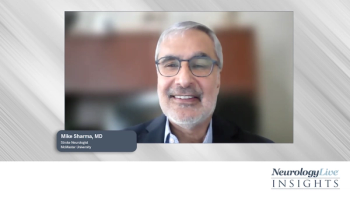
Routine EEG May Be Alternative to Continuous EEG When Resources are Limited
Future studies may validate the use of routine electroencephalogram as an alternative to continuous electroencephalogram in centers with limited resources, as despite better seizure detection with continuous monitoring, outcomes were similar between the methods.
Emily J. Gilmore, MD, MS
Results from the first-of-its-kind pragmatic multicenter Continuous EEG Randomized Trial in Adults (CERTA) study (NCT03129438) revealed that continuous electroencephalogram (cEEG) is superior to routine electroencephalogram (rEEG) for seizure detection and modification of antiseizure treatment in critically ill patients, but is not related to improved outcomes.1
The study, led by Andrea O. Rossetti, MD, director, EEG/Epilepsy Unit and Sleep Center, Lausanne University Hospital, included 364 patients (33% women; mean age, 63 years [standard deviation (SD), 15]) who had acute consciousness impairment and no recent seizures. They were randomized 1:1 to cEEG for 30 to 48 hours or 2 rEEGs for 20 minutes each, with follow-up at 6 months. Mortality at 6 months represented the primary outcome, while interictal and ictal features detection and change in therapy were among the secondary outcomes.
At 6 months, mortality was reported for 89 of 182 patients in those with cEEG and 88 of 182 in those with rEEG (adjusted relative risk [RR], 1.02; 95% CI, 0.83—1.26; P = .85). However, cEEG was associated with increased detection of interictal features (adjusted RR, 1.26; 95% CI, 1.08—1.15; P = .004) and seizures (adjusted RR, 3.37; 95% CI, 1.63—7.00; P = .001).
“There is literature, even quite recent literature—mostly from North America—describing, on the one side, an increasing use of continuous EEG for this indication in these sorts of patients, and on the other side, the yield of this procedure in identifying seizures or interictal/ictal continuum features in these patients,” Rossetti said in an accompanying JAMA Neurology author interview.2 “What’s not known, for our study, is whether the identification of seizures—and, consequently, the treatment of seizures—may influence the outcomes of these patients.”
READ MORE:
Rossetti told JAMA Neurology that with many institutions lacking the resources to conduct and properly monitor continuous EEF, properly identifying which patients can most benefit from its use could allow for better care of these patients.
In a related editorial, Emily J. Gilmore, MD, MS, associate professor, staff neurointensivist, Yale School of Medicine, commented on the results, stating that “given the number of patients likely to benefit from cEEG and limited capacity of cEEG monitoring at most hospitals, the goal should not be to use the data from Rossetti et al. to debunk the use of cEEG but rather justify the use of irEEG in resource-restricted hospitals for lower-risk patients.”3
Patients in this study were admitted to the hospital for brain injury (including cardiac arrest; n = 218), medical (n = 104), surgical (n =40 ), or other (n = 9) reasons.
Changes in antiseizure drug (AED) prescription within 60 hours following start of EEG intervention occurred in 39 (21.1%) patients on cEEG compared to 21 (11.5%) patients with rEEg (RR, 1.84; 95% CI, 1.12—3.00; P = .01). Additionally, changes in sedation prescription within 60 hours following start of EEG intervention occurred in 13 (7%) and 8 (4.4%) patients on cEEG and rEEG interventions, respectively (RR, 1.61; 95% CI, 0.683—3.79; P = .27).
The study recruited critically ill adults having Glasgow Coma Scale scores of 11 or lower or Full Outline of Responsiveness score of 12 or lower, without recent seizures or status epilepticus. Furthermore, each patient had either cerebral conditions such as brain trauma, cardiac arrest, hemorrhage, or stroke, or noncerebral conditions including toxic-metabolic or unknown etiology.
Subgroups that stratified patients according to age, premorbid disability, comorbidities on admission, deeper consciousness reduction, and underlying diagnoses revealed no significant effect modification from the 2 interventions. Other variables such as Cerebral Performance Category (CPC) did not change across groups while modified Rankin Scale (mRS) evolution at 6 months was better in the rEEG group, especially in patients without hypoxic-ischemic encephalopathy.
Death latency, which was analyzed as a measure to explore whether cEEG facilitated decisions of life sustaining treatment withdrawal, was comparable in the subgroup with hypoxic-ischemic encephalopathy (rEEG: median, 8.5 days; range, 0—156; cEEG: median, 6 days; range, 0–157; P = .07) and without (rEEG: median, 11 days; range, 1—130; cEEG: median, 8 days; range 1–176; P = .40; U tests).
Rosetti and colleagues noted that future studies in a more homogenous patient population may validate repeated rEEG as a reasonable alternative to cEEG, at least in centers with limited resources. To that point, Gilmore added, “The study by Rossetti and colleagues should make an impression in the critical care monitoring, epilepsy, and neurocritical care worlds, from which many future studies targeting more homogenous subpopulations and neurophysiologic signatures will hopefully emerge.”
REFERENCES
1. Rosetti AO, Schindler K, Sutter R, et al. Continuous vs routine electroencephalogram in critically ill adults with altered consciousness and no recent seizure: a multicenter randomized clinical trial. JAMA Neurol. Published July 27, 2020. doi: 10.1001/jamaneurol.2020.2264
2. Continuous vs Routine Electroencephalogram in Critically Ill Adults With Altered Consciousness. JAMA Neurology. Audio Author Interview. Published July 27, 2020. Accessed August 7, 2020. https://edhub.ama-assn.org/jn-learning/audio-player/18527639
3. Gilmore E. Continuous electroencephalogram — necessity or luxury? JAMA Neurol. Published July 27, 2020. doi: 10.1001/jamaneurol.2020.1483
Newsletter
Keep your finger on the pulse of neurology—subscribe to NeurologyLive for expert interviews, new data, and breakthrough treatment updates.


































